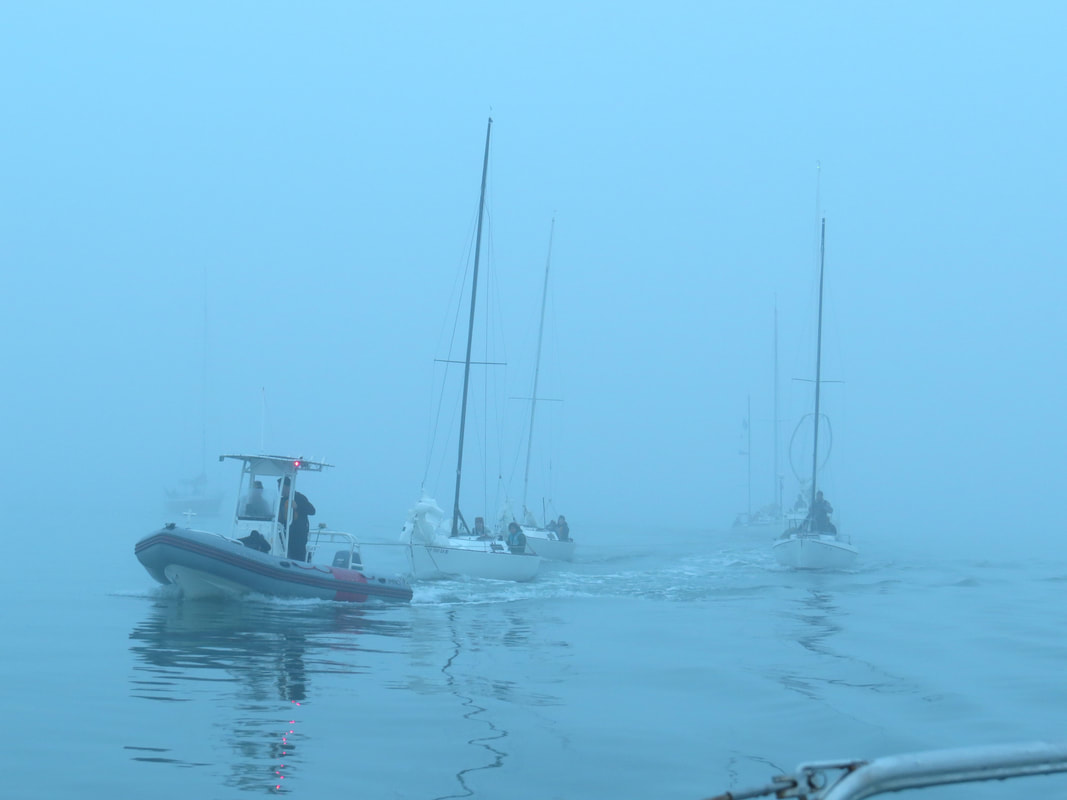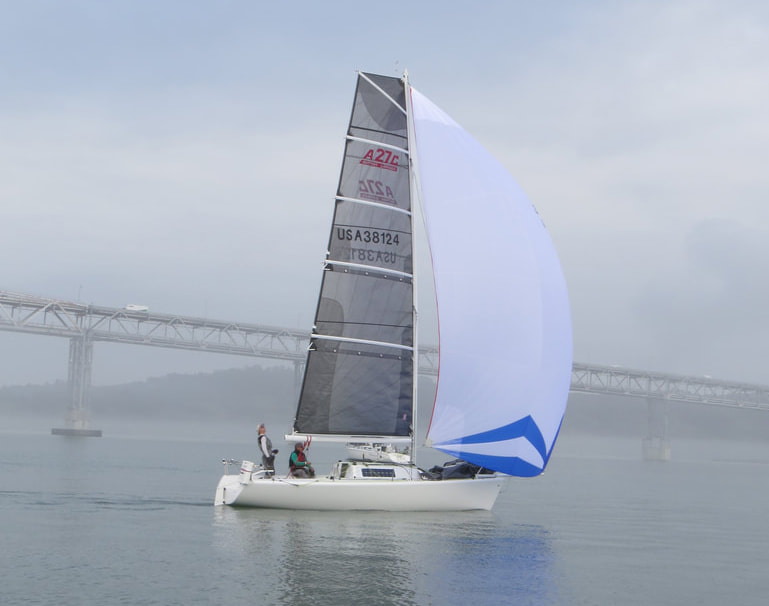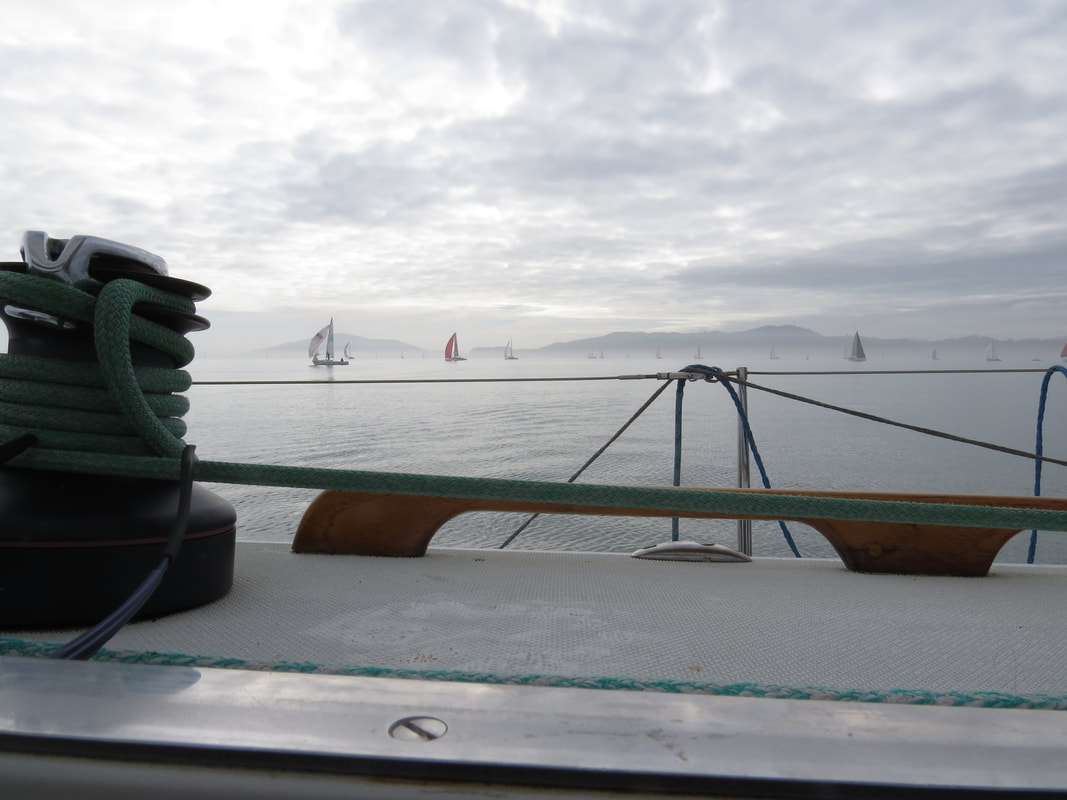The 2020 Three Bridge Fiasco
Through The Fog
To start the Three Bridge Fiasco, you have to get to the starting line.
It was a cool, drippy, foggy Saturday morning on January 25th, as about 300 boats and nearly 600 sailors pushed off their docks all around San Francisco Bay. Under engine power or under tow, they would converge on a magic line running between the Race Deck of San Francisco’s Golden Gate Yacht Club and “X” Buoy. This is where the madness begins, the starting line for the 2020 Three Bridge Fiasco sailing race.
My crew and I arrived at the boat at dawn, loaded down with food for a long day. The Fiasco is a race for single- or double-handed crews only, with autopilots and other short-handed tricks permitted. It’s also started using a “pursuit” format, so the boats with the highest PHRF rating start first, beginning with the Cal 20, Can’O’Whoopass at nine AM. Fastest boats start last. By the time the last boat in the fleet, Peter Stoneberg’s Extreme 40 cat, Shadow Extreme 40, crossed the line, it would be after 11:00.
We motored Shaman, our Cal 40, out of our slip in Richmond’s Brickyard Cove Marina, and joined a mini-convoy of Richmond Yacht Club boats heading across to the Cityfront. There was an RYC rigid inflatable, towing a Moore 24 and two club-owned J22s crewed by high school kids from the junior program. Also, the Wyliecat 39 Checkered Past with Kim Desenberg and Skip Allan towed a fleet of Wylie Wabbit sportboats. We powered at six knots, visibility a quarter mile, grateful Shaman is equipped with a 12” chartplotter that displays AIS targets.
To start the Three Bridge Fiasco, you have to get to the starting line.
It was a cool, drippy, foggy Saturday morning on January 25th, as about 300 boats and nearly 600 sailors pushed off their docks all around San Francisco Bay. Under engine power or under tow, they would converge on a magic line running between the Race Deck of San Francisco’s Golden Gate Yacht Club and “X” Buoy. This is where the madness begins, the starting line for the 2020 Three Bridge Fiasco sailing race.
My crew and I arrived at the boat at dawn, loaded down with food for a long day. The Fiasco is a race for single- or double-handed crews only, with autopilots and other short-handed tricks permitted. It’s also started using a “pursuit” format, so the boats with the highest PHRF rating start first, beginning with the Cal 20, Can’O’Whoopass at nine AM. Fastest boats start last. By the time the last boat in the fleet, Peter Stoneberg’s Extreme 40 cat, Shadow Extreme 40, crossed the line, it would be after 11:00.
We motored Shaman, our Cal 40, out of our slip in Richmond’s Brickyard Cove Marina, and joined a mini-convoy of Richmond Yacht Club boats heading across to the Cityfront. There was an RYC rigid inflatable, towing a Moore 24 and two club-owned J22s crewed by high school kids from the junior program. Also, the Wyliecat 39 Checkered Past with Kim Desenberg and Skip Allan towed a fleet of Wylie Wabbit sportboats. We powered at six knots, visibility a quarter mile, grateful Shaman is equipped with a 12” chartplotter that displays AIS targets.
Line of Terror
The Three Bridges in the Fiasco’s name refer to the three marks of the course, which may be rounded in any direction, and in any order. These marks are Blackaller Buoy, near the South Tower of the Golden Gate Bridge, Red Rock, just south of the Richmond San Rafael Bridge, and Treasure Island, between the West and Eastern spans of the Bay Bridge.
Three bridges. Pick your favorite order, and by the way, you may cross the starting and finish line in either direction. That’s where the terror part happens! For example, in the photo above, the boat on port tack with the red spinnaker is preparing to head for Blackaller, with a whole lot of Moore 24s on starboard tack beating to Treasure Island. The action can be a little intense.
Our start happened at 9:52:30 along with two other Cal 40s, a Cal 39 and some J70s. We’re the 114-raters. Of course, I managed to screw up the start, nearly colliding with a Santa Cruz 27 before doing a big circle near X Buoy. Our Cal 40 competitors, Azure and Sequoia, had escaped as we stalled out in mid-turn. They and most of the others in the fleet of 317 registered starters headed for Treasure Island. We had other plans.
The Three Bridges in the Fiasco’s name refer to the three marks of the course, which may be rounded in any direction, and in any order. These marks are Blackaller Buoy, near the South Tower of the Golden Gate Bridge, Red Rock, just south of the Richmond San Rafael Bridge, and Treasure Island, between the West and Eastern spans of the Bay Bridge.
Three bridges. Pick your favorite order, and by the way, you may cross the starting and finish line in either direction. That’s where the terror part happens! For example, in the photo above, the boat on port tack with the red spinnaker is preparing to head for Blackaller, with a whole lot of Moore 24s on starboard tack beating to Treasure Island. The action can be a little intense.
Our start happened at 9:52:30 along with two other Cal 40s, a Cal 39 and some J70s. We’re the 114-raters. Of course, I managed to screw up the start, nearly colliding with a Santa Cruz 27 before doing a big circle near X Buoy. Our Cal 40 competitors, Azure and Sequoia, had escaped as we stalled out in mid-turn. They and most of the others in the fleet of 317 registered starters headed for Treasure Island. We had other plans.
Tied to the Tide
With “Typical Three Bridge Fiasco weather” in the forecast, meaning light, weird wind conditions, the tide would open doors for the racers during the day and then slam them closed. Kame Richards, proprietor of Pineapple Sails, advised sailors at the Fiasco Skippers Meeting to “head for the bridge closest to your home port.” Kame has also described how he carefully looks at the wind and tide forecasts in advance, makes a well-reasoned plan, and then often discards the whole plan five minutes before the start. In those cases, conditions of the moment dictate a course to avoid groups of stalled boats or to just go where the wind is.
The week before the race, I had studied weather forecasts and looked at the projected currents in this unique and cool L36 Tide & Current Map. With maximum flood tide at ten AM, getting to Red Rock as soon as possible seemed like the best solution, especially with a 3.8-knot ebb peaking at about 4:30 in the afternoon. After our inelegant start, we watched Azure tack away toward the San Francisco cityfront, headed for the Bay Bridge. Sequoia followed, while we stuck to our original plan and headed for Red Rock. We sailed into the gray netherworld, beating toward Alcatraz in a nice northwest breeze, before cracking off to sail past the east side of Angel Island. We were all alone in the fog. As the breeze came aft and gradually died, our six-knot upwind pace gradually reduced to a knot and a half. We felt good, and soon the fog lifted to a revealing haze.
With “Typical Three Bridge Fiasco weather” in the forecast, meaning light, weird wind conditions, the tide would open doors for the racers during the day and then slam them closed. Kame Richards, proprietor of Pineapple Sails, advised sailors at the Fiasco Skippers Meeting to “head for the bridge closest to your home port.” Kame has also described how he carefully looks at the wind and tide forecasts in advance, makes a well-reasoned plan, and then often discards the whole plan five minutes before the start. In those cases, conditions of the moment dictate a course to avoid groups of stalled boats or to just go where the wind is.
The week before the race, I had studied weather forecasts and looked at the projected currents in this unique and cool L36 Tide & Current Map. With maximum flood tide at ten AM, getting to Red Rock as soon as possible seemed like the best solution, especially with a 3.8-knot ebb peaking at about 4:30 in the afternoon. After our inelegant start, we watched Azure tack away toward the San Francisco cityfront, headed for the Bay Bridge. Sequoia followed, while we stuck to our original plan and headed for Red Rock. We sailed into the gray netherworld, beating toward Alcatraz in a nice northwest breeze, before cracking off to sail past the east side of Angel Island. We were all alone in the fog. As the breeze came aft and gradually died, our six-knot upwind pace gradually reduced to a knot and a half. We felt good, and soon the fog lifted to a revealing haze.
We made it slowly to Red Rock, with just a few boats nearby. Most of the boats we saw later turned out to be the few finishers and the fleet winners. In the end we headed home, heeding Kame Richards’ joking advice. With an uncooperative autopilot that wanted to steer us in a circle, and my sweetie feeling the effects of both the flu and a sprained knee, we joined the vast majority of the fleet and headed for our slip.
The Winning Strategy
Jim Antrim, designer and crew on the winning boat, explained their strategy to Mike Josselyn, RYC Storm Jib Racing Editor, “Succeeding in the Three Bridge Fiasco is often a matter of luck. This year, with only 43 finishers and over 270 retirees, good and bad luck loomed large indeed. On io, our good luck began at the start and continued all the way around our clockwise course. Just before the start, the northeast breeze picked up to allow us to try the clockwise approach, running to Blackaller against the flood and getting there in about 25 minutes.”
“The strong flood gave us a significant starboard tack lee bow and pushed us all the way through Raccoon. In the fluky, light-to-nothing breeze at the end of Raccoon and up to Red Rock, we carried late flood longer and got the new northwest wind earlier and stronger than the boats that went straight to Red Rock from the start. We ran to Treasure Island in the strong early ebb, gybing often to stay on the left side of the course in better current and breeze.”
“Our good luck crested with a new westerly for the last third of that leg, enabling us to keep the spinnaker up and powering against the south bay ebb all the way under and past the Bay Bridge and lifting us to the southwest corner of Yerba Buena Island. At that point, the combination of big ebb and a northwest breeze of ten knots got us to the finish in a hurry with only five tacks. We finished at 4:33 PM.”
Overall Results
Fleet Results
Jim Antrim, designer and crew on the winning boat, explained their strategy to Mike Josselyn, RYC Storm Jib Racing Editor, “Succeeding in the Three Bridge Fiasco is often a matter of luck. This year, with only 43 finishers and over 270 retirees, good and bad luck loomed large indeed. On io, our good luck began at the start and continued all the way around our clockwise course. Just before the start, the northeast breeze picked up to allow us to try the clockwise approach, running to Blackaller against the flood and getting there in about 25 minutes.”
“The strong flood gave us a significant starboard tack lee bow and pushed us all the way through Raccoon. In the fluky, light-to-nothing breeze at the end of Raccoon and up to Red Rock, we carried late flood longer and got the new northwest wind earlier and stronger than the boats that went straight to Red Rock from the start. We ran to Treasure Island in the strong early ebb, gybing often to stay on the left side of the course in better current and breeze.”
“Our good luck crested with a new westerly for the last third of that leg, enabling us to keep the spinnaker up and powering against the south bay ebb all the way under and past the Bay Bridge and lifting us to the southwest corner of Yerba Buena Island. At that point, the combination of big ebb and a northwest breeze of ten knots got us to the finish in a hurry with only five tacks. We finished at 4:33 PM.”
Overall Results
Fleet Results






